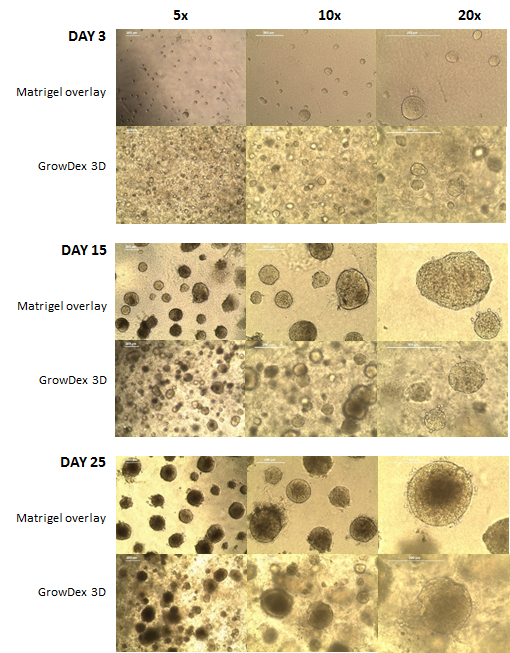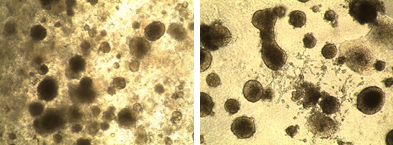Johanna Niklander, University of Helsinki, Finland
Lauri Paasonen, UPM-Kymmene Oyj, Finland
INTRODUCTION
MCF7 is an adenocarcinoma cell line derived from breast tissue with metastatic and pleural effusion morphology (American Type Culture Collection; ATCC). As it is one of the few cancer cell lines expressing estrogen receptor α (ER-α), it is the most published cell line in the field of breast cancer research (1).
Traditional two dimensional (2D) in vitro cell culture systems are being replaced by more functional three dimensional (3D) models. 3D cell culture provides cells with biologically more relevant microenvironment concerning stiffness and ECM dependent regulation to form 3D cell structures, as well as physiologically more relevant diffusion for drug efficacy studies (2, 3). In order to avoid the unknown factors in the culture system, the development of clean 3D culture scaffolds that are xeno-free, stable, and non-inducing, is essential for improving the relevancy and repeatability of the in vitro models.
In this study, the morphology development of MCF7 cells in wood-derived nanofibrillar cellulose hydrogel GrowDex® (3D), and in mouse tumor basement membrane extract (BME) Matrigel overlay culture (2.5D) are presented. The results demonstrate that both GrowDex and Matrigel support the formation of 3D spheroids during the 25 days of culture.
MATERIALS
- GrowDex 1.5% (Cat No. 100 103 005, UPM)
- Matrigel GFR (Cat No. 356230, Corning)
- 96-well plates (Cat No. 3370, Corning)
- 8-well chamber slides (Cat No. 177445, Nunc)
- MCF7 cells
- TrypLe Express (Cat No. 12604039, Thermo Fisher)
- Maintenance and 3D culture medium
- 89% RPMI 1640 (Cat No. 22400, Thermo Fisher)
- 11% FBS
- Thaw recovery medium
- 80% RPMI 1640 (Cat No. 22400, Thermo Fisher)
- 20% FBS
METHODS
MCF7 cells were passaged twice a week
- Ratio 1:8 – 1: 12 (ca. 1.8 million cells / T75 flask)
- 1 mL TrypLE / 3min +37°C, centrifugation not used
- Cells were collected with medium to complete the chosen passage ratio volume, and seeded in 1 mL to T75 flask to final 15mL volume
3D culture of MCF7 in GrowDex
- MCF7 were cultured in 0.37% GrowDex concentration
- Cell seeding density was 25k cells / 100 µL GrowDex / 96-well
- 130 µL culture medium was added on top of GrowDex
- Medium was replaced every other day, and every day after culture day 10
2.5D culture of MCF7 cells on Matrigel
- 45 µL undiluted Matrigel coating / 8 well chamber slide (pre-hardened with 20min / +37°C incubation)
- 3000 cells were seeded in 300 µL 2% v/v Matrigel –medium mix / 8 well chamber slide
- 400 µL culture volume for 2% v/v Matrigel–medium
RESULTS AND DISCUSSION
MCF7 cells formed 3D spheroid structures both in GrowDex and Matrigel and the cells did not reduce their growth rate during the 25 days culture time (Fig. 1). Some apoptosis could be detected during cultures, starting from day 9.
The 3D environment of GrowDex with the cells seeded inside the hydrogel supported more homogenous and round spheroid morphology (Fig 2A). Matrigel overlay culture system seemed to enable spheroid merging and enhance randomly shaped, uncontrolled growth (Fig 2B). This could be as a consequence of various proteins and growth factors being present in the mouse tumor derived material.
3D cell culture enables more physiologically relevant models for various applications and it also gives novel insights into the biology of the disease. For example, in recent study with MCF7 3D assay it was demonstrated that in addition to the known ability of estrogen to promote cell proliferation, it may also inhibit metastasis indirectly via rearrangement of the actin cytoskeleton (4).

Figure 1. MCF7 cells cultured in 0.37% GrowDex and 2% v/v Matrigel overlay culture imaged at 3 days, 15 days and 25 days timepoints. Images were taken with 5x, 10x, and 20x objectives. Scale bar in all images is 200µm.

GrowDex 3D Matrigel overlay
Figure 2. MCF7 spheroids in GrowDex (A) and Matrigel (B) on culture day 25. Spheroid merging and heterogenous spheroid morphology was enhanced in Matrigel cultures. Images were taken with 5x objective.
CONCLUSIONS
Improved functionality and relevancy of 3D cultures offer better in vitro models for e.g. disease modelling, drug development and toxicity assessment. Here we demonstrated that MCF7 breast cancer cells form 3D spheroid structures both in GrowDex and Matrigel. Spheroid merging and uncontrolled growth that was observed in Matrigel may be due to the presence of unknown amounts of different ECM proteins, growth factors and other biological signaling molecules in the material. Round spheroid morphology was observed in GrowDex. As a plant-based cellulose hydrogel, GrowDex offers an animal-free, clean, and well defined matrix for advanced MCF7 3D cell models. Further optimization of cell seeding density between 15-25k cells / 100 µl is recommended.
REFERENCES
- Lee A.V., Oesterreich S., Davidson N.E. (2015). MCF-7 Cells—Changing the Course of Breast Cancer Research and Care for 45 Years. Journal of National Cancer Institute, 107: djv073.
- Härmä V., Virtanen J., Mäkelä R., Happonen A., Mpindi J-P., Knuuttila M., Kohonen P., Lötjönen J., Kallioniemi O., Nees M. (2010). A Comprehensive Panel of Three-Dimensional Models for Studies of Prostate Cancer Growth, Invasion and Drug Responses. Plos One, 5: e10431.
- Li L, Lu Y. (2011). Optimizing a 3D Culture System to Study the Interaction between Epithelial Breast Cancer and Its Surrounding Fibroblasts. Journal of Cancer, 2:458-466.
- Padilla-Rodriguez M., Parker S.S., Adams D.G., Westerling T., Puleo J.I., Watson A.W., Hill S.M., Noon M., Gaudin R., Aaron J., Tong D., Roe D.J., Knudsen B., Mouneimne G. (2018). The actin cytoskeletal architecture of estrogen receptor positive breast cancer cells suppresses invasion. Nature Communications, 9: 2980.